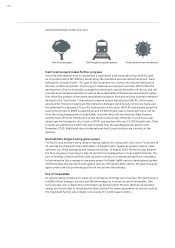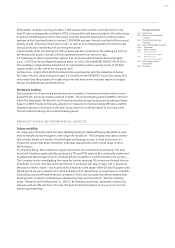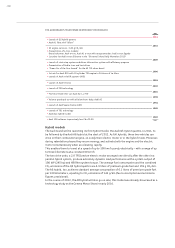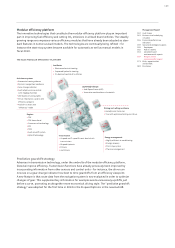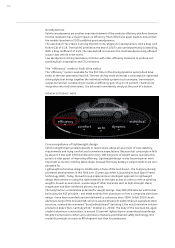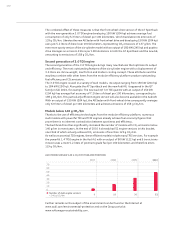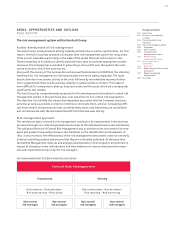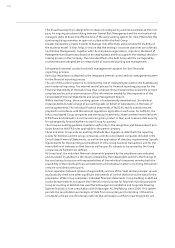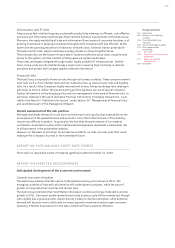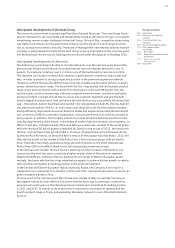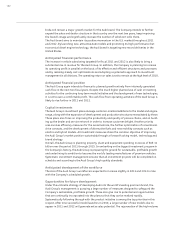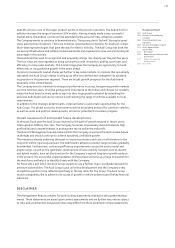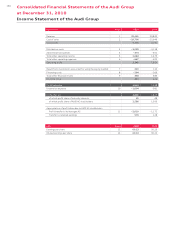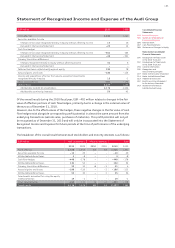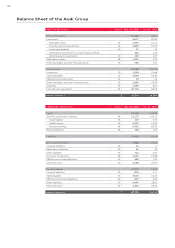Audi 2010 Annual Report Download - page 178
Download and view the complete annual report
Please find page 178 of the 2010 Audi annual report below. You can navigate through the pages in the report by either clicking on the pages listed below, or by using the keyword search tool below to find specific information within the annual report.
176
The Audi Group performed exceptionally well amid this environment and posted new record
levels of vehicle deliveries and profit.
One major factor behind this success has been the Audi Group’s young, attractive product range.
Another has been the extensive, sustained measures implemented by the Company in the past
to improve costs and processes, optimize structures and reduce fixed costs in order to respond
more flexibly to major fluctuations in demand.
Furthermore, the Audi Group continually monitors the market with the aid of early indicators in
order to anticipate fluctuations in sales and be in a position to respond by adjusting manufacturing
output accordingly. Additional flexibility is created by its ability to transfer production between
the various locations under the production turntable principle and the effective use of timebanking.
The development of international raw materials markets presents a further risk for the Audi
Group. All raw materials markets of relevance for the Company are continually monitored in
order to secure adequate supplies of production materials and minimize the cost risks. In addi-
tion, comprehensive hedging strategies are implemented.
As a car manufacturer, the development in the crude oil price is moreover hugely significant to
the Audi Group. An unremitting rise in the price of oil, coupled with higher production and energy
costs for the Company, could also lead to rising fuel costs. This would then potentially make
customers more reluctant to buy cars. The Audi Group has already responded promptly by stead-
ily optimizing conventional drive systems, implementing far-reaching efficiency measures on
vehicles and developing alternative fuels and new drive concepts such as hybrid and electric
vehicles. The Company is already able to offer its customers a wide range of vehicles that are
ideal for those eager to drive particularly efficient, progressive automotive concepts.
As a company with worldwide operations, the Audi Group generates a large portion of its revenue
in foreign currency. This exposes it to unforeseeable exchange rate fluctuations in the euro, which
could adversely affect consolidated net profit. The main foreign exchange risks involve the pound
sterling, the Japanese yen and the U.S. dollar. To counter these risks, the Audi Group employs
appropriate hedging instruments to an economically reasonable extent and in close, continuous
consultation with the Volkswagen Group.
Other risk factors constitute unforeseeable political intervention in the economy, an escalation
in political tension, terrorist attacks, natural disasters and possible pandemics, all of which
could also have a detrimental effect on the Audi Group’s business performance by undermining
economic activity or international capital markets. The Audi Group restricts such risks by preparing
emergency plans and taking out adequate insurance cover.
Industry risks
Now that the financial and economic crisis has been overcome, the situation on international
financial markets has further eased. There has been a marked improvement in access to borrowed
capital and banks’ elevated risk surcharges for large sections of the automotive industry. Thanks
to the Audi Group’s successful business performance in recent years, it has high liquidity at its
disposal and therefore considers itself to be well equipped to tackle the challenges of the future
without needing recourse to external financial resources.
Along with the sharp rise in global demand for cars, the situation in the used-car market has
likewise improved substantially. This has ultimately had a positive effect on the measurement of
residual value risks. Thanks to the Audi Group’s cautious use of vehicle financing instruments
within its profit-oriented growth strategy, it is exposed to only modest economic risk here. Its
long-established conservative approach to the assessment of residual values by the residual
value committee when concluding vehicle financing is effective in mitigating risks. In the absence
of a dramatic deterioration in the situation on the used-car market, the Audi Group assumes that
the risks from sales of used cars are adequately covered.


